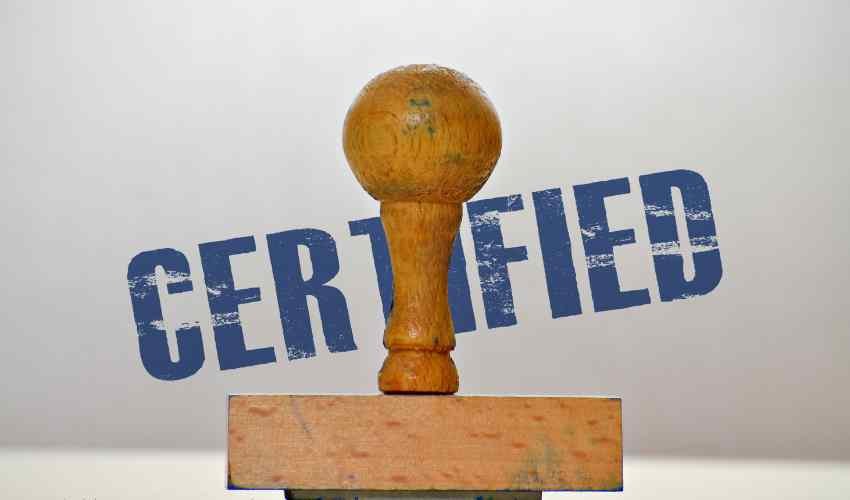BLOG

How To Get Good Manufacturing Practices Certified?
Good Manufacturing Practices (GMP) are essential for companies in industries like food, pharmaceuticals, and cosmetics. GMP certification ensures that your production processes meet stringent quality standards, which helps build trust with consumers, regulators, and partners. Obtaining Good Manufacturing Practices certification can be complex, but with the proper knowledge and preparation, your company can meet the necessary standards. This article provides a step-by-step guide on how to get GMP certified, focusing on the GMP certification requirements, GMP training for employees, and the associated GMP certification cost.
What Is GMP Certification?
GMP Certification verifies that a manufacturing facility complies with specific regulatory standards to ensure product safety and quality. These regulations encompass various aspects of production, including hygiene, equipment maintenance, personnel qualifications, and more. Companies in pharmaceuticals, biotechnology, food and beverages, and dietary supplements typically seek Good Manufacturing Practices certification.
Why Is GMP Certification Important?
Adhering to Good Manufacturing Practices regulations is crucial for companies that produce consumable goods. Not only does GMP certification help ensure the safety and efficacy of products, but it also builds credibility with consumers and authorities. In many countries, entering certain markets or securing contracts with larger companies is often a legal requirement.
Key Steps to Get GMP Certified
Understand GMP Standards
Before beginning the certification process, it’s crucial to understand the GMP certification requirements for your specific industry. Good Manufacturing Practices standards can vary based on the type of products you’re manufacturing (e.g., pharmaceuticals vs. food), and they may be enforced by different regulatory bodies, such as the U.S. Food and Drug Administration(FDA) or the European Medicines Agency (EMA). Common requirements include:
- Detailed documentation of manufacturing processes.
- Consistent quality control testing.
- Proper sanitation and hygiene protocols.
- Employee training on GMP standards.
- Regular inspections and audits.
Conduct a Gap Analysis
A gap analysis assesses your current practices against Good Manufacturing Practices standards to identify areas that need improvement. This step helps you prioritize necessary changes before applying for certification. Typically, companies hire consultants or internal auditors to conduct a thorough review of their processes, equipment, and facilities.
Implement Corrective Actions
Based on the results of the gap analysis, your company will need to make the necessary changes to meet GMP standards. This may involve updating equipment, improving sanitation protocols, or revising documentation procedures. Depending on the results of the gap analysis, this stage can be time-consuming and may require a significant investment.
Employee Training
An essential part of GMP compliance is ensuring that all employees know and adhere to Good Manufacturing Practices standards. GMP training for employees is mandatory to ensure that everyone in the facility—from production staff to quality control personnel—understands their role in maintaining Good Manufacturing Practices compliance. Employees should receive regular GMP training certification, and this training should be documented as part of your GMP compliance records.
Documentation
One of the most critical aspects of GMP compliance is proper documentation. Good Manufacturing Practices guidelines require companies to keep detailed records of every step in the production process, from sourcing raw materials to final product delivery. This documentation is essential for proving compliance during inspections and audits.
Conduct Internal Audits
Conduct internal audits before applying for official certification to ensure that all procedures comply with Good Manufacturing Practices standards. This helps identify any lingering issues and allows you to correct them before an official inspection. Internal audits should be conducted regularly after obtaining GMP Certification to ensure ongoing compliance.
Apply for Good Manufacturing Practices Certification
Once you’ve implemented corrective actions, completed GMP training for employees, and conducted internal audits, you’re ready to apply for certification. You’ll need to submit an application to a certification body that offers Good Manufacturing Practices certification for your industry. After your application is reviewed, an auditor will inspect your facility to verify compliance.
Pass the Certification Audit
During the certification audit, the auditor will evaluate your manufacturing processes, employee training records, and documentation to ensure they meet Good Manufacturing Practices standards. After successfully passing the audit, your company will receive a Good Manufacturing Practices certification, which is typically valid for one to three years, depending on the certifying body.
What Is the GMP Certification Cost?
The GMP certification cost varies depending on several factors, including the size of your facility, the complexity of your production processes, and the certifying body. Generally, costs range from $10,000 to $50,000. Additional costs may include:
- Consultant fees for gap analysis.
- Employee training programs.
- Equipment upgrades or replacements.
- Internal auditing expenses.
While the upfront GMP certification cost may be substantial, the long-term benefits, such as improved product quality, regulatory compliance, and increased marketability, often outweigh the investment.
GMP Training for Employees
A critical element of maintaining compliance with Good Manufacturing Practices is employee training. GMP training for employees ensures that everyone involved in the production process understands the importance of adhering to Good Manufacturing Practices standards. Training should cover:
- Personal hygiene and safety protocols.
- Proper handling and storage of materials.
- Documentation procedures.
- Quality control checks.
Upon completion of the training, employees should receive a GMP training certification, which serves as proof that they have met the required standards. This certification should be updated regularly as regulations and company procedures evolve.
Maintaining Good manufacturing practices Certification
Once you’ve obtained Good Manufacturing Practices certification, the work doesn’t stop. Good Manufacturing Practice-certified companies must undergo periodic audits to ensure ongoing compliance. These audits may be scheduled or unannounced depending on the certifying body and regulatory requirements. Maintaining proper documentation, conducting internal audits, and offering regular GMP training for employees is essential for retaining your certification.

Good Manufacturing Practices FAQs
What is GMP certification, and why do I need it?
Good Manufacturing Practices certification verifies that your manufacturing facility meets specific quality and safety standards. It’s often required for regulatory compliance and helps build trust with customers and partners.
How much does it cost to get GMP certified?
The GMP certification cost varies but generally ranges from $10,000 to $50,000, depending on factors like facility size and complexity. Costs also include gap analysis, employee training, and potential equipment upgrades.
What are the key GMP certification requirements?
Key GMP certification requirements include thorough documentation, quality control procedures, employee training, sanitation protocols, and passing an audit by a certifying body.
Do employees need to be trained for GMP compliance?
Yes, GMP training for employees is essential for ensuring that all staff understand and comply with Good Manufacturing Practices standards. Employees should receive regular GMP training certification to prove their knowledge of these practices.
How long does it take to get GMP certified?
The timeline varies depending on the current state of your facility and operations
